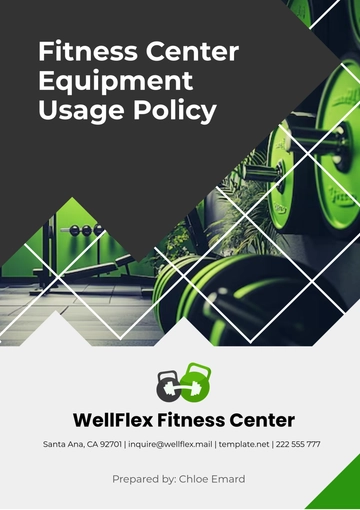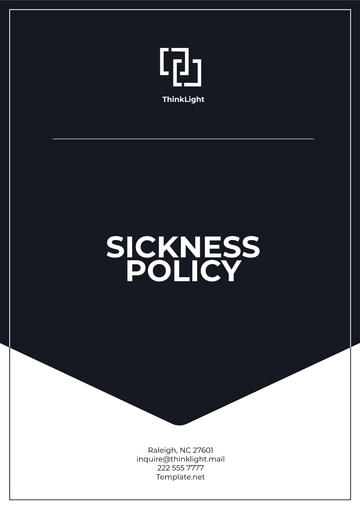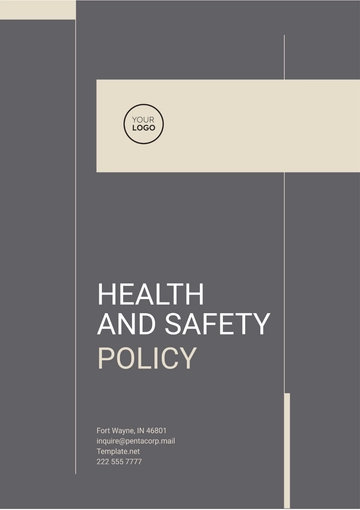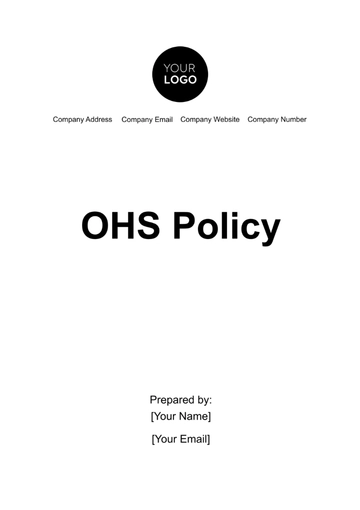Free OHS Policy

I. Introduction
A. Purpose
The purpose of [Your Company Name]'s Occupational Health and Safety (OHS) Policy is to ensure that every employee works in a safe and healthy environment, free from hazards that could lead to accidents or illnesses. [Your Company Name]'s objective is to identify potential risks and implement measures to mitigate them effectively. This policy demonstrates our commitment to maintaining high standards of workplace safety and to protecting the well-being of our employees. By fostering a proactive safety culture, we aim to prevent incidents and ensure a safe working environment for all.
B. Scope
This policy applies to all employees, contractors, and visitors at all locations operated by the organization. It covers all workplace activities, including those performed on-site and at off-site locations where employees may be engaged in business activities. Any activities or operations outside the scope of this policy must adhere to their respective safety guidelines or standards. This comprehensive approach ensures that safety measures are consistently applied across all areas of the organization.
II. Policy Statement
A. Commitment to Health and Safety
Our organization is dedicated to creating and maintaining a safe work environment through continuous improvement and adherence to health and safety regulations. We are committed to providing the necessary resources and support to implement effective safety practices and procedures.
Our primary objective is to forestall any occurrences of accidents and health-related issues by employing a strategy that focuses on proactive risk management as well as actively involving every employee in the process. We advocate for the cultivation of a safety-conscious culture within the organization, where it is paramount for each individual to assume accountability not only for their personal safety but also for the safety of their colleagues.
B. Legal Compliance
We are committed to complying with all relevant local, national, and international health and safety laws and regulations. This commitment includes staying updated with any changes in legal requirements and ensuring that our policies and practices are aligned with current standards.
Periodic audits and thorough reviews will be systematically conducted to verify our adherence to legal standards and to identify and address any existing or potential shortcomings. Ensuring compliance with legal requirements is a fundamental aspect of our health and safety management system, illustrating our steadfast commitment to upholding a lawful, safe, and secure workplace environment.
III. Responsibilities
A. Employer Responsibilities
Senior management is responsible for providing leadership and ensuring that adequate resources are allocated to health and safety initiatives. They must enforce the implementation of safety policies and practices and support ongoing training and development for all employees. Management is also responsible for conducting regular safety audits and addressing any identified issues promptly. By leading by example, they set the tone for a culture of safety and responsibility throughout the organization.
B. Employee Responsibilities
Employees are expected to adhere to all health and safety policies and procedures and to actively participate in maintaining a safe work environment. This includes reporting any safety hazards or incidents to their supervisors immediately and following all safety training and instructions. Employees should use personal protective equipment as required and engage in safe work practices to prevent accidents. Cooperation with safety measures and a commitment to reporting potential risks contribute to the overall safety culture of the workplace.
C. Health and Safety Personnel
Health and safety personnel are responsible for developing, implementing, and maintaining the organization's health and safety programs and procedures. They will conduct regular inspections and risk assessments to identify and address potential hazards. These personnel will also lead safety training sessions and provide guidance to employees on best practices. Their role includes monitoring compliance with safety policies and recommending improvements to enhance overall workplace safety.
IV. Risk Management
A. Hazard Identification
Hazard identification will be carried out through systematic inspections, employee feedback, and analysis of incident reports. We will utilize various tools and techniques to assess potential risks associated with workplace activities and environments.
Hazard identification is an ongoing and perpetual process that is dedicated to the recognition and assessment of new or emerging risks as they manifest. By engaging in proactive identification, we are enabled to address and mitigate potential hazards before they have the opportunity to escalate into incidents or cause injuries. This approach ensures that we remain vigilant and responsive to any changes in the risk landscape, thereby fostering a safer and more secure environment.
B. Risk Control
To control identified risks, we will implement a hierarchy of controls, including elimination, substitution, engineering controls, administrative controls, and personal protective equipment. Each control measure will be evaluated for effectiveness and adjusted as necessary based on ongoing monitoring and feedback.
The strategies designed to control and manage risks within the organization will be meticulously documented in detail and subsequently communicated to all employees. This ensures that everyone within the company is well-informed and capable of implementing these strategies effectively. Our main goal is to minimize risks by prioritizing and selecting the most effective control measures, ensuring a safer work environment for all.
C. Emergency Procedures
Emergency procedures will be developed and communicated to all employees to ensure a swift and effective response in case of emergencies. These procedures will include evacuation plans, emergency contact numbers, and specific instructions for various types of emergencies.
Regularly scheduled practice drills will be performed to ensure that all employees become thoroughly familiar with emergency protocols. These drills will also serve to evaluate the effectiveness of the established response plans. It is of utmost importance to maintain updated and current emergency procedures, as this is essential for ensuring that employees are well-prepared to respond quickly and safely during critical situations.
V. Training and Communication
A. Training Programs
All employees will undergo initial and ongoing training to ensure they understand and adhere to health and safety policies and procedures. Training programs will cover a range of topics including hazard recognition, risk management, and emergency response.
In order to assess the effectiveness of our training programs, we will conduct thorough evaluations and solicit feedback from participants. These steps will enable us to identify areas for improvement and ensure our training initiatives remain relevant and effective. Additionally, we will keep detailed and comprehensive records of all training activities, documenting each employee's participation and compliance with the training requirements. These records will serve as a vital tool for tracking progress and ensuring that all employees meet the necessary standards.
B. Communication Channels
Effective communication is essential for maintaining awareness and compliance with health and safety policies. We will use various channels, such as newsletters, email updates, and safety meetings, to keep employees informed about safety practices and changes to policies.
Employees are encouraged to proactively raise any safety concerns they might have or to provide any suggestions for improvements through the company's established communication channels. This process is seen as vital because it promotes open and transparent communication within the organization. Such transparency helps ensure that important safety information is not only widely disseminated but also appropriately acted upon, fostering a safer and more responsive workplace environment.
VI. Monitoring and Review
A. Policy Review
The Occupational Health and Safety (OHS) Policy will undergo a thorough review each year to guarantee that it remains pertinent and effective. This comprehensive review process will include an in-depth assessment of the policy's overall performance, careful consideration of feedback provided by employees, and a meticulous evaluation of the policy's compliance with the latest regulations.
Should there be any new risks identified or changes in legal requirements, necessary updates or revisions will be implemented accordingly. By conducting these regular reviews, we ensure that the policy continues to be effective and stays in line with the best practices in the field of health and safety.
B. Performance Monitoring
We will implement a robust system to monitor the performance of health and safety measures and policies. This includes tracking key performance indicators, analyzing incident reports, and conducting regular audits. Monitoring efforts will help identify areas for improvement and ensure that safety measures are effective.
In the event that there are any occurrences or instances where compliance is not met or there are deviations from established standards and protocols, such situations will be carefully and thoroughly addressed by implementing corrective actions. Furthermore, if it is deemed necessary based on the specific circumstances or the nature of the non-compliance, additional training and educational measures may also be put into place to rectify the issues and prevent future recurrences.
VII. Documentation and Record-Keeping
A. Record Maintenance
Accurate and up-to-date records of health and safety activities will be maintained to support compliance and continuous improvement. This includes documentation of incidents, training sessions, safety inspections, and risk assessments. Records will be stored securely and retained for the period required by law or organizational policy.
In order to protect the confidentiality and integrity of the information contained within the records, access will be limited exclusively to personnel who have received the necessary authorization. This measure ensures that sensitive data remains secure and is handled only by individuals who have been granted permission to view and manage it.
B. Documentation Procedures
Detailed documentation procedures will be established to ensure all health and safety activities are recorded accurately. This includes specifying formats for reports, logs, and other safety-related documents. Proper documentation will facilitate effective tracking of safety measures and support evidence-based decision-making.
Thorough and detailed examinations of standard documentation practices will be regularly carried out. These audits are aimed at verifying that all processes align consistently with established policies and adhere strictly to the prescribed guidelines and requirements.
VIII. Review and Update
A. Review Process
The review process for the OHS Policy will involve a thorough evaluation by key stakeholders, including management, employees, and safety experts. Feedback from these stakeholders will be incorporated to ensure the policy meets the needs of the organization and complies with current regulations.
The review of the specified subject matter will be carried out at a minimum once every year, with the possibility of more frequent evaluations if any substantial changes or developments take place. This collaborative methodology is designed to ensure that the policy in question continues to be pertinent and operates effectively in achieving its intended goals.
B. Update Procedures
Updates to the OHS Policy will be communicated to all employees through official channels, such as meetings and written notifications. Revised versions of the policy will be distributed and made accessible on the company’s internal network. Feedback on updated policies will be collected to ensure that they address any concerns or improvements suggested by employees.
Ensuring that updates are implemented both efficiently and effectively will contribute substantially to maintaining ongoing compliance with relevant standards and regulations. Additionally, this approach will support continuous improvements in safety measures, thereby fostering a more secure and regulated environment.
IX. Approval and Implementation
A. Approval
The Occupational Health and Safety (OHS) Policy will go through a formal approval process carried out by senior management. This measure is designed to clearly illustrate the organization's firm commitment to maintaining health and safety standards. The approval process itself will involve a thorough review to ensure that the policy is not only in alignment with the overall goals of the organization but also complies with relevant legal requirements.
Once the policy has been reviewed and approved, detailed documentation of this approval will be kept on record. This documentation serves as tangible evidence of management's endorsement and support for the policy. By following this structured and formal approval procedure, the importance of the OHS Policy is highlighted and its authority within the organization is reinforced.
B. Implementation
Implementation of the OHS Policy will be executed through a structured plan that includes training, communication, and integration into daily operations. Key steps will involve rolling out the policy across the organization and providing support to ensure all employees understand and comply with it. Monitoring will be conducted to track the effectiveness of the implementation and address any issues that arise.
Continuing to provide dedicated support and consistent reinforcement will be essential to guarantee that the policy is thoroughly and successfully woven into the fabric of the organizational culture. This process involves not only the initial implementation but also ongoing efforts to remind and encourage all members of the organization to adopt and adhere to the policy, thereby ensuring its principles are upheld and become an integral part of the daily practices and ethos of the organization.
- 100% Customizable, free editor
- Access 1 Million+ Templates, photo’s & graphics
- Download or share as a template
- Click and replace photos, graphics, text, backgrounds
- Resize, crop, AI write & more
- Access advanced editor
Utilize the OHS Policy Template from Template.net for a streamlined approach to workplace safety. This customizable and editable template allows you to tailor policies to your organization's needs effortlessly. Leverage our AI Editor Tool to refine content and ensure compliance. Perfect for creating a comprehensive and effective Occupational Health and Safety policy quickly and efficiently.
You may also like
- HR Policy
- Restaurant Policy
- Company Policy
- Accounting Policies and Procedures
- Website Policy
- Privacy Policy
- Safety Policy
- School Policy
- IT and Software Policy
- Law Firm Policy
- Construction Policy
- Interior Design Policy
- Travel Agency Policy
- Education Academic Policy
- Security Policy
- Real Estate Policy
- Expense Policy
- Software Policy





























